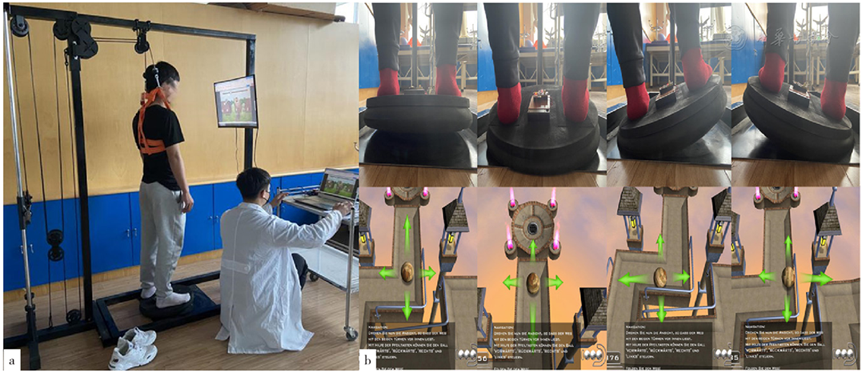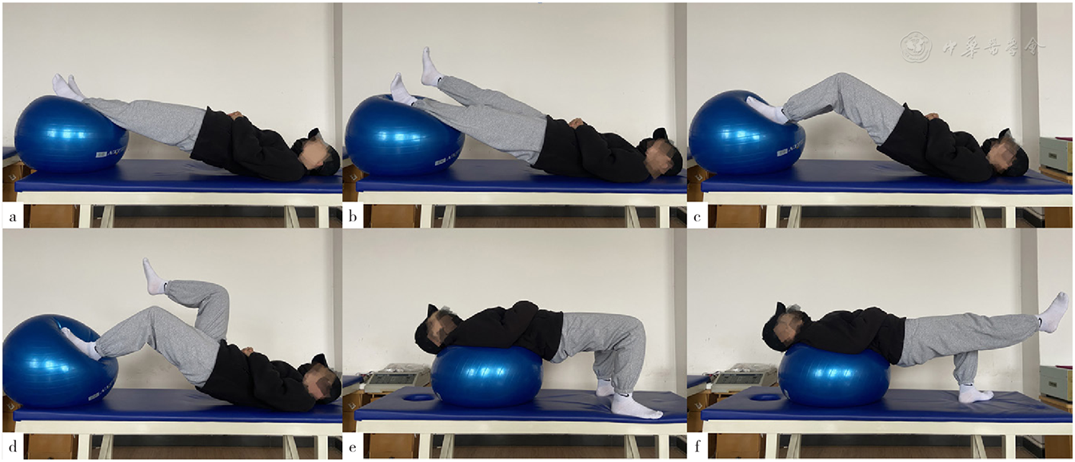中国全科医学 ›› 2023, Vol. 26 ›› Issue (09): 1064-1074.DOI: 10.12114/j.issn.1007-9572.2022.0608
刘晓龙1,2, 何梦晓3,*( ), 尹贻锟1, 杨旸4, 张敬之5
), 尹贻锟1, 杨旸4, 张敬之5
收稿日期:2022-05-06
修回日期:2022-09-15
出版日期:2023-03-20
发布日期:2022-10-31
通讯作者:
何梦晓
基金资助:
LIU Xiaolong1,2, HE Mengxiao3,*( ), YIN Yikun1, YANG Yang4, ZHANG Jingzhi5
), YIN Yikun1, YANG Yang4, ZHANG Jingzhi5
Received:2022-05-06
Revised:2022-09-15
Published:2023-03-20
Online:2022-10-31
Contact:
HE Mengxiao
摘要: 背景 传统核心稳定康复训练在慢性非特异性腰痛(CNSLBP)患者康复训练中的效果确切,但存在患者长期依从性差的问题。本课题组自主研发了核心稳定康复训练系统(专利号:2021107165452),但其在CNSLBP患者中的干预效果尚不明晰。 目的 探究核心稳定康复训练系统对CNSLBP患者的干预效果。 方法 选取2021年12月至2022年1月在广西师范大学、桂林学院内招募的21例男性CNSLBP患者为研究对象,将其随机分为试验组(n=11)与对照组(n=10)。试验组采用课题组自主研发的核心稳定康复训练系统进行训练,对照组采用传统核心稳定训练,共干预6周。干预前后分别采用视觉模拟评分法(VAS)评估患者疼痛程度,采用功能障碍指数(ODI)评价腰部功能障碍,采用Hoggan MicroFet 2肌肉与骨骼检测仪测定患者腰部前屈肌群、后伸肌群、回旋肌群肌力及肌力信号,采用Y平衡测试(YBT)评定动态平衡能力。 结果 试验组、对照组干预后VAS值、ODI值低于干预前(P<0.05),上腹屈、脊柱伸、脊柱左旋、脊柱右旋肌力高于干预前(P<0.05);干预后试验组VAS值、ODI值低于对照组(P<0.05);试验组与对照组干预后左侧、右侧YBT得分高于干预前(P<0.05),干预后试验组左侧、右侧YBT得分高于对照组(P<0.05)。 结论 传统核心稳定训练与采用核心稳定康复训练系统进行训练均能减轻CNSLBP患者腰部疼痛,改善腰部功能障碍,增加上腹屈、脊柱伸和脊柱回旋肌力,提高动态平衡能力,而采用核心稳定康复训练系统进行训练在减轻腰部疼痛、改善腰部功能障碍、提高动态平衡能力方面效果更好。

图1 试验组训练方法注:a为患者站立于平衡板上,在康复治疗师引导下进行核心康复训练;b中长箭头所指方向为虚拟对象运动方向
Figure 1 Intervention using the core stabilization rehabilitation training program for the experimental group

图2 对照组训练方法注:a~f分别为双桥运动、单桥运动、屈膝双桥运动、屈髋屈膝单桥运动、反桥运动、单腿反桥运动示意图
Figure 2 Intervention using the usual Bobath ball core stabilization training program for the control group
| 组别 | 例数 | 年龄(岁) | BMI(kg/m2) | 病程(周) |
|---|---|---|---|---|
| 对照组 | 10 | 21.3±1.2 | 22.8±2.9 | 52.6±9.1 |
| 试验组 | 11 | 21.2±1.2 | 22.7±1.6 | 57.3±13.4 |
| t值 | 0.232 | 0.047 | -0.922 | |
| P值 | 0.819 | 0.963 | 0.368 |
表1 两组患者一般资料比较
Table 1 Comparison of general information of subjects in the two groups
| 组别 | 例数 | 年龄(岁) | BMI(kg/m2) | 病程(周) |
|---|---|---|---|---|
| 对照组 | 10 | 21.3±1.2 | 22.8±2.9 | 52.6±9.1 |
| 试验组 | 11 | 21.2±1.2 | 22.7±1.6 | 57.3±13.4 |
| t值 | 0.232 | 0.047 | -0.922 | |
| P值 | 0.819 | 0.963 | 0.368 |
| 组别 | 例数 | VAS值(分) | ODI值(%) | ||||||
|---|---|---|---|---|---|---|---|---|---|
| 干预前 | 干预后 | t配对值 | P值 | 干预前 | 干预后 | t配对值 | P值 | ||
| 对照组 | 10 | 5.40±2.22 | 4.260±1.93 | 6.000 | <0.001 | 28.40±12.39 | 16.70±9.93 | 9.121 | <0.001 |
| 试验组 | 11 | 5.73±1.62 | 2.09±1.22 | 8.414 | <0.001 | 30.36±14.53 | 8.09±8.09 | 8.575 | <0.001 |
| t值 | -0.389 | -3.021 | -0.331 | -2.186 | |||||
| P值 | 0.702 | 0.007 | 0.744 | 0.041 | |||||
表2 两组患者干预前后VAS值、ODI值比较
Table 2 Comparison of VAS and ODI values of subjects before and after intervention in two groups
| 组别 | 例数 | VAS值(分) | ODI值(%) | ||||||
|---|---|---|---|---|---|---|---|---|---|
| 干预前 | 干预后 | t配对值 | P值 | 干预前 | 干预后 | t配对值 | P值 | ||
| 对照组 | 10 | 5.40±2.22 | 4.260±1.93 | 6.000 | <0.001 | 28.40±12.39 | 16.70±9.93 | 9.121 | <0.001 |
| 试验组 | 11 | 5.73±1.62 | 2.09±1.22 | 8.414 | <0.001 | 30.36±14.53 | 8.09±8.09 | 8.575 | <0.001 |
| t值 | -0.389 | -3.021 | -0.331 | -2.186 | |||||
| P值 | 0.702 | 0.007 | 0.744 | 0.041 | |||||
| 组别 | 例数 | 上腹屈肌力 | 下腹屈肌力 | |||||||||
|---|---|---|---|---|---|---|---|---|---|---|---|---|
| 干预前 | 干预后 | t配对值 | P值 | 干预前 | 干预后 | t配对值 | P值 | |||||
| 对照组 | 10 | 21.64±2.24 | 27.69±5.24 | -3.155 | 0.012 | 19.19±3.35 | 18.69±5.24 | 0.219 | 0.832 | |||
| 试验组 | 11 | 20.56±3.36 | 26.87±5.17 | -4.996 | 0.001 | 18.42±2.57 | 19.60±6.51 | -0.581 | 0.574 | |||
| t值 | 0.853 | -0.359 | 0.596 | 0.320 | ||||||||
| P值 | 0.404 | 0.723 | 0.558 | 0.752 | ||||||||
| 组别 | 脊柱伸肌力 | 脊柱左旋肌力 | 脊柱右旋肌力 | |||||||||
| 干预前 | 干预后 | t配对值 | P值 | 干预前 | 干预后 | t配对值 | P值 | 干预前 | 干预后 | t配对值 | P值 | |
| 对照组 | 20.93±1.12 | 32.81±8.44 | -4.501 | 0.001 | 14.11±1.28 | 16.62±1.11 | -6.617 | <0.001 | 14.26±1.52 | 16.41±1.87 | -2.335 | 0.044 |
| 试验组 | 21.23±3.17 | 29.86±2.69 | -6.952 | <0.001 | 14.10±1.53 | 17.50±2.21 | -3.969 | 0.003 | 14.22±1.55 | 16.81±2.15 | -3.833 | 0.003 |
| t值 | -0.291 | -1.101 | 0.016 | 1.135 | 0.062 | 0.452 | ||||||
| P值 | 0.775 | 0.285 | 0.987 | 0.270 | 0.951 | 0.656 | ||||||
表3 两组患者干预前后腰部肌肉力量比较(kg)
Table 3 Comparison of in lumbar muscle strength before and after the intervention in two groups
| 组别 | 例数 | 上腹屈肌力 | 下腹屈肌力 | |||||||||
|---|---|---|---|---|---|---|---|---|---|---|---|---|
| 干预前 | 干预后 | t配对值 | P值 | 干预前 | 干预后 | t配对值 | P值 | |||||
| 对照组 | 10 | 21.64±2.24 | 27.69±5.24 | -3.155 | 0.012 | 19.19±3.35 | 18.69±5.24 | 0.219 | 0.832 | |||
| 试验组 | 11 | 20.56±3.36 | 26.87±5.17 | -4.996 | 0.001 | 18.42±2.57 | 19.60±6.51 | -0.581 | 0.574 | |||
| t值 | 0.853 | -0.359 | 0.596 | 0.320 | ||||||||
| P值 | 0.404 | 0.723 | 0.558 | 0.752 | ||||||||
| 组别 | 脊柱伸肌力 | 脊柱左旋肌力 | 脊柱右旋肌力 | |||||||||
| 干预前 | 干预后 | t配对值 | P值 | 干预前 | 干预后 | t配对值 | P值 | 干预前 | 干预后 | t配对值 | P值 | |
| 对照组 | 20.93±1.12 | 32.81±8.44 | -4.501 | 0.001 | 14.11±1.28 | 16.62±1.11 | -6.617 | <0.001 | 14.26±1.52 | 16.41±1.87 | -2.335 | 0.044 |
| 试验组 | 21.23±3.17 | 29.86±2.69 | -6.952 | <0.001 | 14.10±1.53 | 17.50±2.21 | -3.969 | 0.003 | 14.22±1.55 | 16.81±2.15 | -3.833 | 0.003 |
| t值 | -0.291 | -1.101 | 0.016 | 1.135 | 0.062 | 0.452 | ||||||
| P值 | 0.775 | 0.285 | 0.987 | 0.270 | 0.951 | 0.656 | ||||||

图3 试验组1例CNSLBP患者干预前后上腹屈肌力信号变化图注:a为干预前,b为干预后;1~5分别对应第1~5次测试
Figure 3 Signal changes of upper abdominal flexor strength before and after the intervention in one patient with CNSLBP in the experimental group

图4 对照组1例CNSLBP患者干预前后上腹屈肌力信号变化图注:a为干预前,b为干预后
Figure 4 Signal changes of upper abdominal flexor strength before and after intervention in one control CNSLBP patient

图5 试验组1例CNSLBP患者干预前后下腹屈肌力信号变化图注:a为干预前,b为干预后
Figure 5 Signal changes of lower abdominal flexor strength before and after intervention in one patient with CNSLBP in the experimental group

图6 对照组1例CNSLBP患者干预前后下腹屈肌力信号变化图注:a为干预前,b为干预后
Figure 6 Signal changes of lower abdominal flexor strength before and after intervention in one control CNSLBP patient

图7 试验组1例CNSLBP患者干预前后脊柱伸肌力信号变化图注:a为干预前,b为干预后
Figure 7 Signal changes of spinal extensor before and after intervention in one patient with CNSLBP in the experimental group

图9 试验组1例CNSLBP患者干预前后脊柱左旋肌力信号变化图注:a为干预前,b为干预后
Figure 9 Signal changes of spinal levator muscle strength before and after intervention in one patient with CNSLBP in the experimental group

图10 对照组1例CNSLBP患者干预前后脊柱左旋肌力信号变化图注:a为干预前,b为干预后
Figure 10 Signal changes of spinal levator muscle strength before and after intervention in one control CNSLBP patient

图11 试验组1例CNSLBP患者干预前后脊柱右旋肌力信号变化图注:a为干预前,b为干预后
Figure 11 Signal changes of right spinal muscle strength before and after intervention in one patient with CNSLBP in the experimental group

图12 对照组1例CNSLBP患者干预前后脊柱右旋肌力信号变化图注:a为干预前,b为干预后
Figure 12 Signal changes of right spinal muscle strength before and after intervention in one control CNSLBP patient
| 组别 | 例数 | 左侧 | 右侧 | ||||||
|---|---|---|---|---|---|---|---|---|---|
| 干预前 | 干预后 | t配对值 | P值 | 干预前 | 干预后 | t配对值 | P值 | ||
| 对照组 | 10 | 80.37±4.83 | 86.23±5.40 | -19.672 | <0.001 | 79.15±5.04 | 85.12±5.82 | -16.903 | <0.001 |
| 试验组 | 11 | 81.91±5.26 | 95.61±1.37 | -10.633 | <0.001 | 79.21±6.66 | 95.12±2.53 | -9.942 | <0.001 |
| t值 | -0.696 | 5.574 | -0.023 | 5.192 | |||||
| P值 | 0.495 | <0.001 | 0.982 | <0.001 | |||||
表4 两组患者干预前后动态平衡能力比较(%)
Table 4 Pre-and post-intervention dynamic balance abilities in two groups
| 组别 | 例数 | 左侧 | 右侧 | ||||||
|---|---|---|---|---|---|---|---|---|---|
| 干预前 | 干预后 | t配对值 | P值 | 干预前 | 干预后 | t配对值 | P值 | ||
| 对照组 | 10 | 80.37±4.83 | 86.23±5.40 | -19.672 | <0.001 | 79.15±5.04 | 85.12±5.82 | -16.903 | <0.001 |
| 试验组 | 11 | 81.91±5.26 | 95.61±1.37 | -10.633 | <0.001 | 79.21±6.66 | 95.12±2.53 | -9.942 | <0.001 |
| t值 | -0.696 | 5.574 | -0.023 | 5.192 | |||||
| P值 | 0.495 | <0.001 | 0.982 | <0.001 | |||||
| [1] |
|
| [2] | |
| [3] |
许思毛,张敬之,刘晓龙. 核心稳定训练对慢性非特异性腰痛影响的Meta分析[J]. 河南师范大学学报(自然科学版),2022,50(2):150-156. DOI:10.16366/j.cnki.1000-2367.2022.02.019.
|
| [4] |
王雪强. 核心稳定训练对非特异性腰痛患者神经肌肉功能的作用[D]. 上海:上海体育学院,2016.
|
| [5] |
刘芳,敖丽娟. 核心肌稳定性训练对腰痛康复治疗的意义[J]. 中国康复医学杂志,2017,32(2):231-234.
|
| [6] |
刘合建. 一种核心稳定训练康复系统:CN209348030U[P]. 2019-09-06.
|
| [7] |
刘丽辉,朱立斌,刘书勇,等. 带测速功能的转髋核心力量训练装置研制[J]. 实验技术与管理,2018,35(3):101-104. DOI:10.16791/j.cnki.sjg.2018.03.025.
|
| [8] |
张婵娟,李悦龙,张洲,等. 运动控制训练改善慢性非特异性腰痛的fMRI研究[J]. 中国康复医学杂志,2022,37(3):303-310.
|
| [9] |
中国康复医学会脊柱脊髓专业委员会专家组. 中国急/慢性非特异性腰背痛诊疗专家共识[J]. 中国脊柱脊髓杂志,2016,26(12):1134-1138. DOI:10.3969/j.issn.1004-406X.2016.12.16.
|
| [10] |
万丽,赵晴,陈军,等. 疼痛评估量表应用的中国专家共识(2020版)[J]. 中华疼痛学杂志,2020(3):177-187.
|
| [11] |
严广斌.视觉模拟评分法[J].中华关节外科杂志(电子版),2014,8(2):34.
|
| [12] |
程继伟,王振林,刘伟,等. Oswestry功能障碍指数的改良及信度和效度检验[J]. 中国脊柱脊髓杂志,2017,27(3):235-241.
|
| [13] |
苏朕鑫,杨贤罡,何文革. 运动人群动态平衡能力测试:YBT的产生及发展[J]. 中国运动医学杂志,2021,40(9):737-744. DOI:10.16038/j.1000-6710.2021.09.014.
|
| [14] |
唐桥,张海忠. FMS和YBT预测中国优秀军事五项运动员损伤发生率的研究[J]. 成都体育学院学报,2019,45(3):94-99. DOI:10.15942/j.jcsu.2019.03.015.
|
| [15] |
林科宇,许轶,王楚怀,等. 悬吊式核心稳定训练对慢性非特异性下背痛的疗效[J]. 中国康复医学杂志,2014,29(10):923-928.
|
| [16] |
|
| [17] |
宋晓动,周红海,朱顺昌,等. 脊柱整体性理论与临床相关研究概述[J]. 中华中医药杂志,2019,34(3):1134-1138.
|
| [18] |
陈景洲,王惠娟,石真润,等. 慢性非特异性腰痛患者躯干肌的等速力学特征和肌电信号研究[J]. 中国康复医学杂志,2021,36(1):51-56.
|
| [19] |
崔东,李泽华,宋学军. 慢性疼痛的脊髓机制[J]. 中国疼痛医学杂志,2017,23(9):641-647.
|
| [20] |
翟永夷,崔燕红,徐浩坤. 核心稳定运动对慢性非特异性腰痛患者β-内啡肽和皮质醇水平的影响[J]. 颈腰痛杂志,2021,42(1):100-102.
|
| [21] |
|
| [22] |
刘艳丽,赵祥虎,夏扬,等. 悬吊训练对产后腰痛的效果[J]. 中国康复理论与实践,2018,24(12):1456-1460.
|
| [23] |
|
| [24] |
王万宏,李琳琳,徐朦婷,等. 悬吊训练对慢性下腰背痛患者疼痛、残障、肌力和焦虑的影响[J]. 康复学报,2019,29(1):54-57.
|
| [25] |
陈炳霖,郭佳宝,李欣,等. 青年慢性非特异性腰痛患者腰部本体感觉及其与肌力的相关性[J]. 中国康复医学杂志,2017,32(2):187-191. DOI:10.3969/j.issn.1001-1242.2017.02.012.
|
| [26] |
|
| [27] |
章礼勤,高崇,许世波,等. 腰痛患者和健康人动态平衡功能的研究[J]. 中国康复医学杂志,2015,30(7):720-722.
|
| [28] |
陈昕,王盛,朱奕,等. 人体平衡功能与上肢活动关系研究进展[J]. 中国康复医学杂志,2018,33(1):114-117.
|
| [29] |
付光亮,孟庆华,鲍春雨. 功能性踝关节不稳者本体感觉力学差异及平衡训练干预效果[J]. 应用力学学报,2021,38(6):2426-2431.
|
| [30] |
葛乐,余秋华,郑福明,等. 腰痛对老年女性动静态平衡功能的影响[J]. 中国康复医学杂志,2022,37(6):760-764.
|
| [31] |
陈璟,王纯. 核心稳定性训练可改善背肌肌耐力及等速肌力峰值[J]. 中国组织工程研究,2018,22(36):5797-5802.
|
| [1] | 屠金康, 李方方, 吴晓琼, 习冲, 戚少华, 陈君. 反重力跑台系统的倒走训练结合常规腰背核心训练治疗非特异性腰痛的效果研究[J]. 中国全科医学, 2023, 26(33): 4203-4206. |
| [2] | 胡婧伊, 洪景, 郭晓冬, 张晓红, 莫宁, 周小翠, 余钦, 周敏华, 孙艳, 倪柳, 石晓丽, 苏小青, 李玉倩. 社区参与安宁疗护对临终期肿瘤患者干预效果的Meta分析[J]. 中国全科医学, 2023, 26(28): 3573-3584. |
| [3] | 孙晓蕾, 雷晓龙, 林佳声, 李克良, 郭澳, 张晓辉. 高能量激光联合特定运动疗法对特发性脊柱侧凸伴腰痛患者多裂肌超声形态学的影响研究[J]. 中国全科医学, 2023, 26(27): 3456-3462. |
| [4] | 王珺, 吴佳霏, 王依景, 郑博月, 王宇, 江川艳, 李慧. 以达雷妥尤单抗为基础的化疗方案对多发性骨髓瘤疗效和预后影响的真实世界研究[J]. 中国全科医学, 2023, 26(18): 2256-2262. |
| [5] | 柳兰萍, 杨越, 黄漫, 马晓晶, 叶永铭, 刘晓旭, 林蕙泽, 朱可欣, 郭盛楠, 费宇彤, 杨涛, 于金娜. 基于改良德尔菲法构建《非特异性腰痛针灸临床实践指南》临床问题[J]. 中国全科医学, 2023, 26(09): 1037-1043. |
| [6] | 林蕙泽, 闫文茜, 张萍萍, 费静雯, 申江红, 柳兰萍, 王翔, 朱可欣, 杨涛, 于金娜. 针灸治疗慢性非特异性腰痛随机对照试验结局指标的现状研究[J]. 中国全科医学, 2023, 26(09): 1053-1063. |
| [7] | 费静雯, 林蕙泽, 张萍萍, 柳兰萍, 王翔, 申江红, 朱可欣, 杨涛, 于金娜. 运动针法可有效提高急性非特异性腰痛有效性:一项Meta分析[J]. 中国全科医学, 2023, 26(09): 1044-1052. |
| [8] | 黎霞, 李多多, 程潞瑶, 万颖, 于长禾. 中西医治疗慢性腰痛临床研究的有效率定义及其判定标准存在差异:一项概况性评价[J]. 中国全科医学, 2022, 25(20): 2534-2540. |
| [9] | 何聪聪, 孟利敏, 刘慧珍, 郭秀芳, 王菲菲, 林栋美. 非药物干预措施对癌症患者症状群干预效果的网状Meta分析[J]. 中国全科医学, 2022, 25(19): 2414-2420. |
| [10] | 李巧梅, 王一卉, 余莉, 王鹏举, 高银燕, 赵虹琳, 丁国武. 睡眠时间和睡眠质量对我国中老年人腰背痛发生风险的影响研究[J]. 中国全科医学, 2022, 25(11): 1327-1333. |
| [11] | 石志宜,卢颖,刘纬华,王真真,张红梅. 补充替代医学治疗在妊娠相关下腰痛患者中应用的研究进展[J]. 中国全科医学, 2021, 24(9): 1095-1101. |
| [12] | 陈千吉, 陈红, 张英, 万颖, 周彦吉, 安易, 孙亚男, 于长禾. 患者报告结局测量工具选择路径:以中国腰痛患者日常生活活动能力量表的选择为例[J]. 中国全科医学, 2021, 24(36): 4648-4652. |
| [13] | 季燕,丁静,丁兰,刘美星. 初级卫生保健机构频繁就诊与干预现状研究[J]. 中国全科医学, 2020, 23(25): 3160-3163. |
| [14] | 汪敏加,税晓平,王国瀚,罗毅,王纯. 慢性腰痛患者髋关节周围肌群肌力特征研究[J]. 中国全科医学, 2019, 22(22): 2705-2708. |
| [15] | 费秀文,郑嘉堂,孔玉侠,董爱梅. 老年骨质疏松症的全科诊疗思路[J]. 中国全科医学, 2019, 22(18): 2262-2266. |
| 阅读次数 | ||||||
|
全文 |
|
|||||
|
摘要 |
|
|||||





